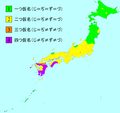Kanazukai (仮(か)名(な)遣(づか)い, ‘kana usage’) are the orthographic rules for spelling Japanese in kana. All phonographic systems (of which kana is an example)...
3 KB (362 words) - 16:03, 28 October 2024
Historical kana orthography (redirect from Rekishiteki Kanazukai)
historical kana orthography (歴史的仮名遣い, rekishiteki kanazukai), or old orthography (旧仮名遣い, kyū kanazukai), refers to the kana orthography (正仮名遣い, sei kana-zukai)...
25 KB (1,904 words) - 23:35, 19 October 2024
Modern kana usage (redirect from Gendai Kanazukai)
gendai kanazukai) is the present official kanazukai (system of spelling the Japanese syllabary). Also known as new kana usage (新仮名遣い, shin kanazukai), it...
6 KB (562 words) - 19:11, 28 September 2024
Jōdai Tokushu Kanazukai (上代特殊仮名遣, lit. Special kana orthography of the early era) is an archaic kana orthography system used to write Old Japanese during...
11 KB (719 words) - 07:11, 27 August 2024
pronunciation was rectified as part of a general orthographic reform, the Gendai Kanazukai, or modern kana orthography. Under the new orthographic rules, only the...
5 KB (399 words) - 00:12, 29 September 2024
example, the word かなづかい, romanized kanadukai in Nihon-shiki, is pronounced kanazukai in modern standard Japanese and is romanized as such in Kunrei-shiki....
24 KB (2,101 words) - 01:46, 10 November 2024
the word かなづかい, rendered kanadukai in Nihon-shiki, is pronounced as kanazukai in modern Japanese, and is romanized as such in Kunrei. The International...
9 KB (632 words) - 01:40, 28 October 2024
Japan. Hashimoto is especially noted for the discovery of Jōdai Tokushu Kanazukai, which makes it clear that Old Japanese made more syllabic distinctions...
2 KB (113 words) - 18:14, 9 January 2023
はなぢ. Similarly, tsukau (使う/遣う; 'to use') is spelled つかう in hiragana, so kanazukai (仮名遣い; 'kana use', or 'kana orthography') is spelled かなづかい in hiragana...
52 KB (4,207 words) - 23:52, 3 November 2024
represented by specific characters. That usage is known as Jōdai Tokushu Kanazukai and usage has led historical linguists to conclude that certain disparate...
23 KB (1,213 words) - 02:59, 19 September 2024
phonetic. See Old Japanese for further information. See Jōdai Tokushu Kanazukai for information on subscript notation. Japanese uses separate systems...
32 KB (2,591 words) - 01:53, 27 September 2024
relative, and its equivalents in Old Japanese. Note: See Jōdai Tokushu Kanazukai for information on Old Japanese subscript notation. Both languages use...
36 KB (1,376 words) - 13:32, 28 September 2024
previously stalled revisions could proceed. The major reforms were: gendai kanazukai (現代仮名遣い)—alignment of kana usage with modern pronunciation, replacing...
37 KB (4,216 words) - 17:16, 28 October 2024
position. Although removed from the standard orthography with the gendai kanazukai reforms, wi and we still see stylistic use, as in ウヰスキー for whisky and...
31 KB (2,933 words) - 09:14, 4 October 2024
November 1946, the newspaper adopted the modern kana usage system (shin kanazukai). On 30 November 1949, the Asahi Shimbun started to publish the serialized...
43 KB (4,476 words) - 09:40, 4 November 2024
(710-794) Old Japanese (a, i, ï, u, e, ë, o, and ö, see Jōdai Tokushu Kanazukai), which merged into the five modern vowels (a, i, u, e, and o). During...
30 KB (3,429 words) - 11:31, 30 August 2024
the loss of certain spelling distinctions found in the Jōdai Tokushu Kanazukai ("Ancient Special Kana Usage"), which distinguished two types of /i/,...
66 KB (4,885 words) - 19:01, 5 November 2024
usage underwent official reform to reflect modern pronunciation as gendai kanazukai (現代かなづかい, modern kana usage). In addition, two kana, ゐ/ヰ wi and ゑ/ヱ we...
34 KB (4,474 words) - 17:45, 15 July 2024
man'yōgana, an archaic orthography that may be used to express Jōdai Tokushu Kanazukai. While it is an Early Middle Japanese text, it is early enough to still...
4 KB (437 words) - 21:12, 21 September 2024
phonology, making important contribution to the studies of Jōdai Tokushu Kanazukai and Middle Chinese. Works on-line Archived 2018-09-29 at the Wayback Machine...
1 KB (76 words) - 16:36, 19 October 2024
with the exception of /to1, to2/, distinguishes between Jōdai Tokushu Kanazukai. It contains a total of 162 Japanese words, many of which are the oldest...
4 KB (333 words) - 23:46, 18 May 2024
text includes a number of passages utilizing the archaic Jōdai Tokushu Kanazukai spellings. However, there are some inconsistencies which indicate that...
3 KB (414 words) - 18:45, 27 April 2024
written in man'yōgana during the Nara period and found the Jōdai Tokushu Kanazukai, proving that there were 88 sounds in the ancient language, but jindai...
10 KB (1,112 words) - 14:44, 22 July 2024
kana-jo, 古今集仮名序 Kokinshū kana-jo, or simply 仮名序 kana-jo; rekishi-teki kanazukai: 假名序) is one of the two prefaces to the tenth-century Japanese waka anthology...
5 KB (567 words) - 22:04, 30 September 2023
last Early Middle Japanese text to preserve any kind of Jōdai Tokushu Kanazukai, where the distinction is only made between type A and type B ko. Bailey...
4 KB (548 words) - 21:57, 4 September 2024
preserves a historical phonological distinction known as Jōdai Tokushu Kanazukai that was soon lost afterwards. 8th century in poetry Rabinovitch, page...
3 KB (487 words) - 11:40, 27 May 2021







